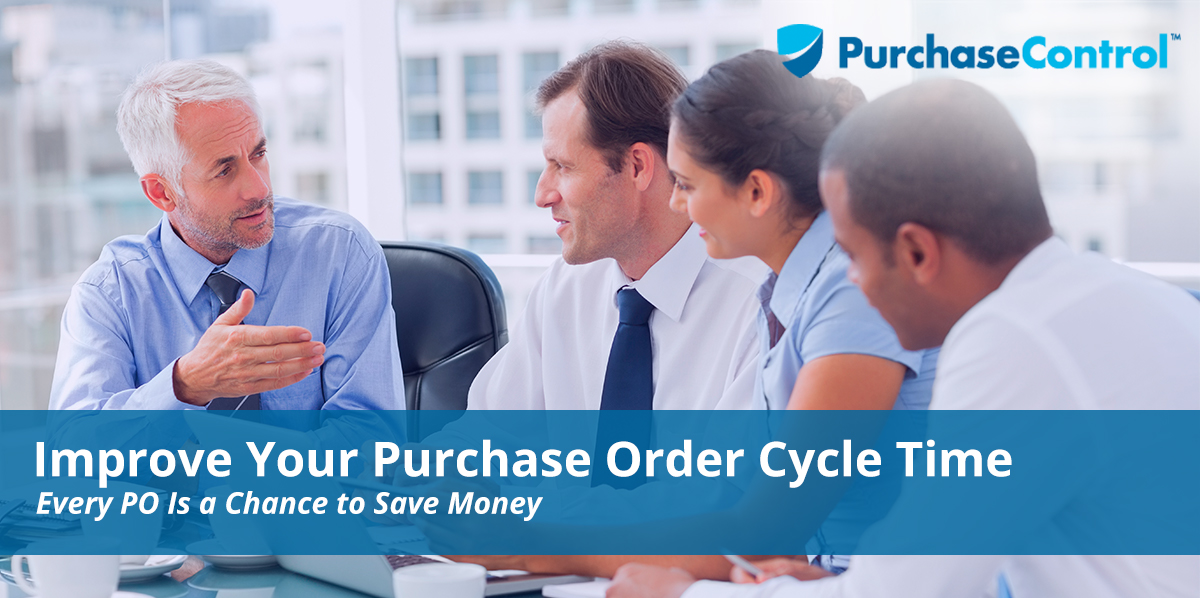The cost of doing business isn’t always measured in mega-purchases like acquisitions, raw material expenditures, or new product lines. Optimizing the “little things” like your company’s purchase order cycle time (also called PO cycle time) can have a substantial impact on both cost savings and value creation through continuous improvement initiatives.
Benefits of Optimized Purchase Order Cycle Time
A central component of a larger procurement cycle—which measures the total time it takes for a transaction to travel from requisition to delivery to payment in full—purchase order cycle time is one of the key performance indicators (KPIs) you can use to measure the productivity and efficiency of your procurement team. This KPI measures the average amount of time it takes for a purchase requisition to generate a purchase order that’s then sent to the supplying vendor.
According to Open Standards Benchmarking established by the American Productivity and Quality Center (APQC), companies qualifying as “top performers” average five hours or less to place a purchase order with their suppliers. Compare this to “bottom performers,” who average two days, and you begin to see how substantial cost savings can be generated from taming and trimming the purchase order cycle to its leanest, fastest (but still accurate) form. Reducing your PO cycle time reduces immediate expenses for every purchase while simultaneously reducing the overall cost of the procurement function itself.
“Internal process improvement that supports cycle time reduction can be accomplished in a number of ways, but two of the most effective ways to streamline your purchase order cycle time, and your overall purchasing process, are automation and supply chain management.”
The Average Purchase Order Cycle
Optimizing your PO cycle begins with understanding its workflow. Every company is different, but in general the purchase order cycle follows a simple path:
1. Generating the Purchase Order
With the purchase requisition approved, staff create a linked purchase order. If the order has more than one line item associated with it, each item ordered will be linked to a new purchase order referring to the same original purchase requisition.
2. Budget Review and Requests for Proposal (RFPs)
After a purchase order has been created, finance will review the budget for the requested items to ensure funds are available. If the company has a software solution in place to automate contract review and assignment, the order is routed to the correct supplier automatically. The process moves directly to Step Five: Review of Delivered Goods.
If procurement remains largely a manual process, then procurement staff will send requests for proposals to potential suppliers. Vendors interested in fulfilling the order will submit quotes that include total cost, lead time, delivery time, and other terms.
3. Supplier Review
For manual procurement teams, this stage is for the review and comparison of the bids submitted to the requirements established in the purchase order. Once the most qualified bid is confirmed by all stakeholders, the winning bidder is selected.
4. Negotiation and Purchase Order Submission
If the purchasing company doesn’t have an automated solution for procurement, the next step is negotiation with the supplier for terms, price, and quality of goods. After negotiations conclude to the satisfaction of both parties, procurement sends the purchase order to the supplier. At this stage, the purchase order is a legally binding contract between the two parties.
Optimizing Your Purchase Order Cycle Time
Internal process improvement that supports cycle time reduction can be accomplished in a number of ways, but two of the most effective ways to streamline your purchase order cycle time, and your overall purchasing process, are automation and supply chain management.
Automation
As a business grows and matures, its procurement cycle can become increasingly complex, consuming a high amount of resources, time, and talent even as it generates revenue for the company. Transferring your workflow to a procurement software solution opens up the possibilities that come from automation, trimming time, expenses, and stress from your team’s workday.
Automation’s primary benefits come from reduction of human error, increased efficiency thanks to fewer assets being required to complete a given task, and increased productivity by staff who can dedicate their time and talents to more valuable tasks within their respective roles. It accomplishes these through the use of artificial intelligence (AI) and machine learning, both of which facilitate transfer of low-level and repetitive tasks such as data entry out of the hands of human beings and into a centralized data management system.
This same system simultaneously connects all users and provides hierarchies of access, review, approval, and payment, whether they’re local or using an app. The end result is a significant decrease in your PO cycle time, accompanied by fewer errors and more effective use of work hours across the board.
Companies using automated software packages report an average decrease of approximately 11 hours (an average of 24 hours, compared to an average of 35 hours for manual or spreadsheet-based solutions) according to the APQC. Automation’s ability to remove roadblocks and streamline processes means those extra 11 hours per PO can be used to generate value for your company through supplier relationship management and other higher-value tasks rather than wasted on paperwork, data entry, or chasing exceptions and errors.
Automation also ensures all transactional data is cross-connected with all related documentation. Every PO is tied automatically to its corresponding invoice, shipping documents, correspondence, and profile information (including contract terms, incentives, and penalties) for the fulfilling vendor, making errors rare and easy to correct if they occur. Auditing, whether for process improvement, internal controls, or financial reporting, is also greatly simplified.
Supply Chain Management
In addition to leveraging the power of automation, you can smooth and enhance the PO process with strategic supply chain controls. In tandem with automation, supply chain management supports building long-term, productive and mutually-beneficial supplier relationships possible in three ways: supplier review, supplier reduction, and partnering with preferred suppliers.
- Supplier Review becomes much easier with full access to all contract, correspondence and transaction data through an automated, centralized procurement application. Vendor performance can be tracked with ease, and contract terms adjusted as capabilities change or incentives and penalties are applied.
- Supplier Reduction is a balancing act for most businesses. Ensuring you have critical needs met both directly and via contingency plans can be challenging to balance against the possibility of “vendor bloat.” But with performance data for all vendors available at the touch of a button, it becomes much more feasible to cull underperformers while leaving enough slack to ensure your production needs are met regardless of circumstance.
Regardless of your current number of suppliers, you’ll also be able to negotiate more favorable terms and pricing as you identify growth and partnership opportunities. Better still, you can trim your PO cycle time to the limit by automating and optimizing the journey from PO creation to delivery to a preapproved vendor with the best terms already negotiated and on file. - Partnering with Preferred Suppliers not only gives you expanded access and support for shared initiatives, but a stronger bargaining position with vendors who aspire to preferred status. Every preferred partner is another link in a lean and waste-free procurement process generating not only cost savings, but additional value in the form of data your company can use for financial forecasting, strategic initiatives, and more.
Save Money with Every Purchase
While it’s just one of several KPIs that help you measure your procurement function’s efficiency and efficacy, purchase order cycle time is a smart place to start when you’re looking to reduce waste and lower costs. Investing in automation and supply chain management will not only prove invaluable in reducing your PO cycle time, but provide the toolset you need to make procurement a hub of process improvement, innovation, and value generation for your business.
Automate Your Purchase Order Processing And Reduce Your Purchase Order Cycle Time
Find Out How








